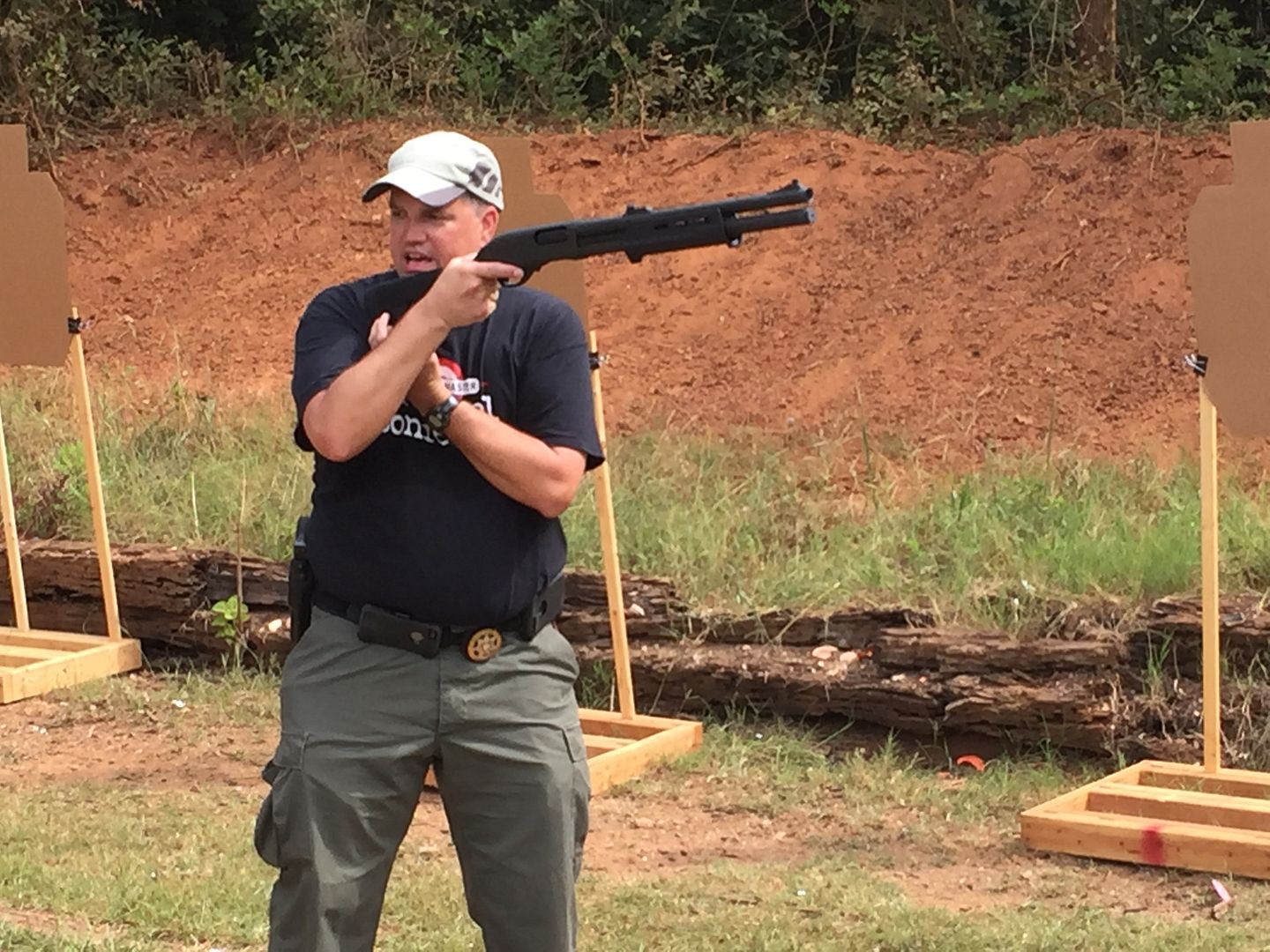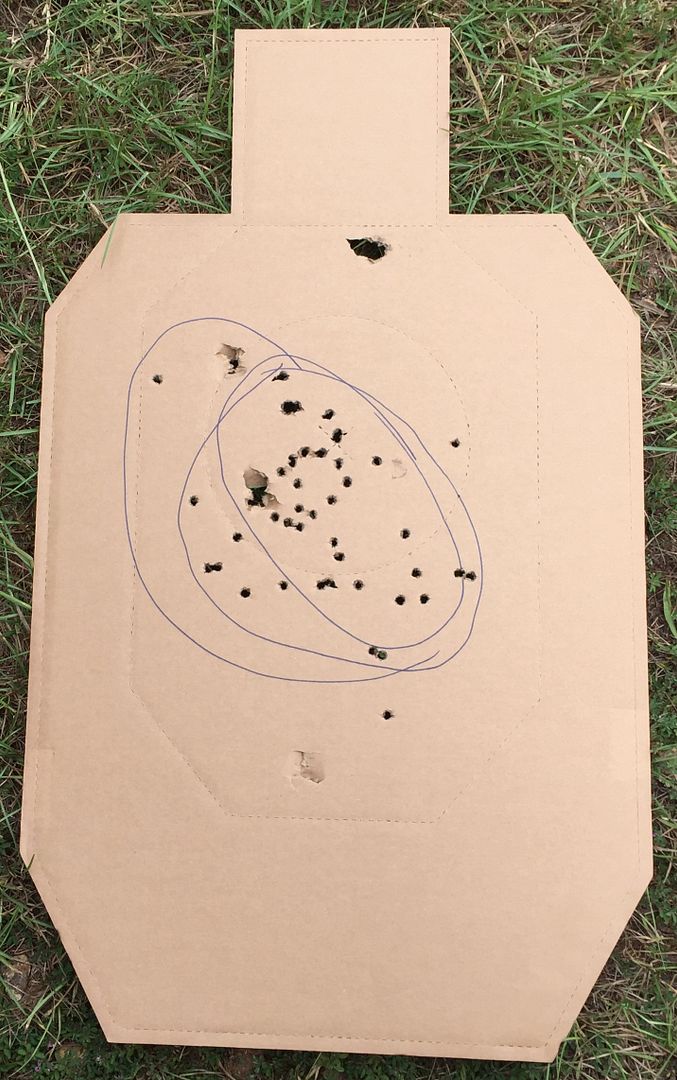The class was billed as a "basic skills course that will progress into challenging drills." As an avid shotgunner I found quite a bit of useful information in both the lecture portion, dryfire portion and the livefire drills. The class was divided into Lecture, Demonstration, Dry Loading And Unloading, Dryfire with various loading drills, Live Fire, Advanced Live Fire Drills, Class Competition, Patterning With Buckshot, Range Cleanup, Final Lecture, and a Class Review. For those that care about such things, those titles are mine and not part of a current course description.
Lecture:
After an initial introduction and safety brief we started with the lecture and Q&A. This portion of the class covered some history of the shotgun and a rather extensive review of the various types. As Lee pointed out multiple times, training with shotguns is rather difficult due to the various loading and unloading procedures, safety locations, capacities and action types available. He spent the time to discuss this in great detail which served us all quite well during the hand's-on portions of the class. While a bit monotonous, this was very necessary information.
One very important point brought up during this phase was that the safeties on shotguns are trigger block safeties. That means that shotguns aren't drop safe. We then moved into proper loaded storage of a shotgun, which is termed Cruiser Ready, Storage Ready, and Gunbox Ready. Those are all terms that Lee has come across in his training and mentioned them as students that choose to further their training may come across them in the future as they are interchangeable. His preferred term was "gunbox ready." He also recommended to keep the magazine downloaded by one round to save the magazine spring. In other words, if the magazine of your shotgun holds seven rounds, only load six and leave the chamber empty. An added benefit is that should one choose to insert a slug in the magazine prior to cycling a round in the chamber there was space in the magazine to do so without removing existing ammo.
On a personal note, I own or have shot multiple brands and styles of shotguns in action style competitions, hunting, sporting clays, skeet, five stand and plinking, if one can legitimately plink with a shotgun. The various loading and unloading procedures as well as the manual of arms, even with shotguns from the same manufacturer can be mind boggling.
Shotguns are notable for their recoil. Learning to properly adjust one's stance and how to correctly mount, or hold the shotgun while shooting makes the experience much less an ordeal. Weight and body mass tend to help with the absorption of recoil as well as the type of shotgun one is using.
Dry Loading And Unloading:
Lee strongly recommended the use of sidesaddles or butt cuffs for extra ammo storage. He provided each student with four inert or dummy rounds for hands-on practice of loading, and especially unloading a shotgun safely. Break action shotguns are easy. Shotguns with tubular magazines are a bit different. Rather than cycling the shells through the chamber and using the extractor and ejector one can use the shell stop to extract the rounds. In the case of some of the newer semi auto shotguns, there are buttons that allow the user to release all the shells at once.
Dryfire:
After all the students exhibited proficiency with the loading and unloading methods unique to their shotgun we started with the dryfire drills. These were integrated with combat loading, or loading a shell through the ejection port, and speed reloads, in which the appropriate number of shells were inserted in the magazine to match the number of shells fired. In other words, "Shoot one, load one. Shoot two, load two."
Livefire:
It was finally time to make bang. We started off with loading one round and firing and quickly progressed to working reloads, speed loads and combat loads from the sidesaddle. All of this portion was done from the seven yard line on cardboard IDPA targets.
Advanced Livefire Drills:
As the drills progressed less instruction was given to the actual steps needed to take to keep the gun loaded. It was up to the student to keep track of the status of the gun. I don't mean to imply round counting so much as following the tenet of "Shoot one, load one." We then participated in the drill known as Rolling Thunder.
Rolling Thunder is an extravaganza of shooting and reloading. Every shooter starts off with fifteen rounds available. One round is loaded into each chamber. At the command to fire, the first shooter fires one shot, the second shooter fires one shot, so on and so forth down the line. When the first shooter has fired his or her first shot, he or she then loads two rounds, as does the second, third and fourth, et cetera. When the last shooter on the line has fired their one shot, the first shooter then fires their two shots, as does the second, third until the last shooter. Meanwhile the first shooter has now loaded three rounds. This continues until everyone on the line has loaded and fired a set of five rounds.
I found this drill to be a good test of one's ability to keep track of the status of their shotgun, remembering how many shots they had fired and needed to load, a small bit of situational awareness, reloading technique, and how hard one could run their chosen shotgun. It was also a lot of fun!
Class Competition:
Another bit of fun with some added pressure. This drill had everyone place their shotgun in Cruiser Ready. For the purposes of this exercise that was four rounds in the magazine, chamber empty. Five steel targets were setup at fifteen yards. Using a shot timer an audible start signal was given and the participant would shoot four of the five steel targets, perform a combat reload, then shoot the fifth target. For students who had never shot in front of a group of critical peers with a timer tracking their performance, the experience was eye opening. It has been noted by several high level trainers that the introduction of a shot timer places a completely different level of stress on the shooter. The use of one is also a good litmus test of where one's skills are.
Patterning With Buckshot:
The class was conducted as a basic familiarization on shotguns for the purposes of home defense. Buckshot is the single best option for this purpose. There was some minor discussion on the various types and weights of buckshot and some technical pros and cons. Lee is a big believer in using the Federal Flight Control 00 Buck. The eight pellet Flight Control tends to hold a tighter pattern than time honored nine and ten pellet 00 Buckshot. Having observed two students in the class using the Flight Control I am a believer.
We patterned from seven, ten, fifteen, twenty and twenty five yards and examined each group for flyers, or stray pellets to have an idea of the limits of effective range on our chosen loads.
Final Lecture:
After the range cleanup we sat down for another lecture which was essentially a recap of the class.
Class Review:
Lee asked us for our input on what could be done better and welcomed constructive criticism.
In conclusion, I thoroughly enjoyed this class. If you're in the market for a shotgun for the purpose of home defense I would suggest you give Lee and First Person Safety consideration for training.



This is a very accurate review of Lee’s Shotgun class. I just completed the course yesterday 7/19/20 and I agree with everything stated above. Lee is extremely knowledgeable and talented with a Shotgun. He has an easy way of instructing that is enjoyable and creates a great learning opportunity. This is an absolute must class if you are using your Shotgun for a defensive weapon. He can help you get the best setup for your gun within the context of how you plan to use it. I very much look forward to the next class I take with Lee. I’ll put my money where me mouth is.
ReplyDeleteDon Neff
Buford GA
This is a very accurate review of Lee’s Shotgun class. I just completed the course yesterday 7/19/20 and I agree with everything stated above. Lee is extremely knowledgeable and talented with a Shotgun. He has an easy way of instructing that is enjoyable and creates a great learning opportunity. This is an absolute must class if you are using your Shotgun for a defensive weapon. He can help you get the best setup for your gun within the context of how you plan to use it. I very much look forward to the next class I take with Lee. I’ll put my money where me mouth is.
ReplyDeleteDon Neff
Buford GA